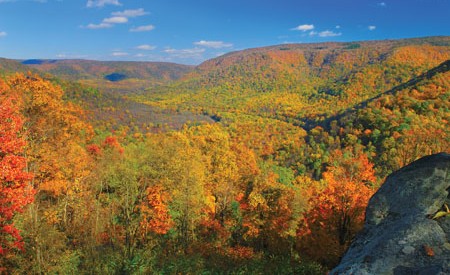Your daily outdoor news bulletin for October 3, the day O.J. Simpson was acquitted in 1995:
Leaf Peeping Party Pooper
Of all the things that don’t work during the current government shutdown, our National Parks are getting a lot of press for being closed. There is the political grandstanding and posturing at the World War II Memorial in D.C., the lost hikers in Crater of the Moon park in Idaho that may or may not be rescued by federal employees, there is the angry rafters at Grand Canyon National Park who have waited years – decades even – for their permits only to be stymied a the put-in, there’s the Panda Cam. It’s a mess for sure, and the economic impact is huge: estimates peg the total daily economic loss at $76 million with D.C. ($5.8 million), North Carolina ($4.4 million), Tennessee ($3.4 million), and Virginia ($3.3 million) all coming in the top 10 states with the biggest loses. Even for people in the government, that’s a lot of money. Although the Blue Ridge Parkway will remain open – the actual road, not the amenities – Great Smoky Mountains National Park and Shenandoah National Park remain closed. This includes all trails, visitors centers, etc. The month of October is one of the busiest months for both these parks, with GSMNP drawing upwards of a million visitors, all of whom have one thing in mind: leaves. The changing colors of the epic expanses of forests is one of the main reasons these two parks are so popular during the fall season. Most national forest trails remain open, even if the facilities are closed. There are some people who will still be able to enjoy our national parks however, those with leases to drill and those that want to log the forests. And then there are the small acts of civil disobedience like the situation at the Pisgah Inn.
BEARS! THEY’RE EVERYWHERE!
Over the past couple of weeks, a spike in bear activity has North Carolinians on edge. They only have one party to blame, and no it’s not the government shutdown – although I’m sure it hasn’t helped authorities deal with the bears. No, they can blame that smallest of nuggets that always tend to stab you in the sweet meat on the bottom of your arch when you walk barefoot to the mailbox: the acorn. A poor acorn crop in the high country has resulted in more bear activity in valley communities like Asheville as the winter hibernation season comes on. Bears are looking for food, and when there is a shortage, the easiest place to find it is in the trashcans of their neighbors, the hungry humans. Although they are mainly on the hunt for acorns at lower elevations, which are plentiful, a bear sighting at Asheville High School put that school on lock down yesterday, and a bear cub was hit by a car on I-26. Experts say to expect the increase in bear activity at lower elevations to continue through the fall and into the winter.
Fracking Tearing Up Pennsylvania Forests
The process of extracting natural gas from the ground via hydraulic fracturing is a relatively new process, and remains unregulated by the EPA, and as such has unknown impacts on the environment and communities. Some of those impacts are known – West Virginians lighting their tap water on fire is the example that immediately comes to mind – but now some more in-depth, more insidious, impacts of fracking are coming to light. A survey has revealed sweeping damage at fracking sites in Pennsylvania, one of the most controversial states when it comes to fracking because there is much public outcry but the states sits on the Marcellus Shale, which many consider the motherlode of deposits. Aerial photos and analysis reveal that fracking is causing sweeping damage and forests fragmented by new well pads, roads, and pipelines. Even a small amount of well sites have a major impact on the surrounding forests, and a deeper look at how ecosystems work reveals why. The theory of island biogeography says that an area’s diversity plummets when habitat is broken up into smaller pieces, as is happening where these drilling sites are, because some animals can only survive in the depths of the forest, not around it’s edges.
Read the full story at grist.org.








